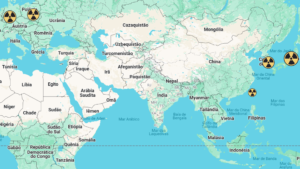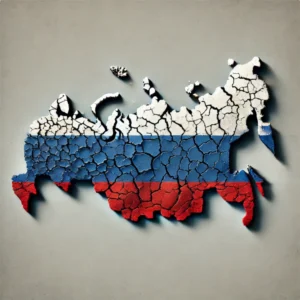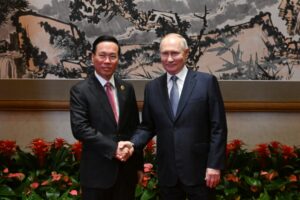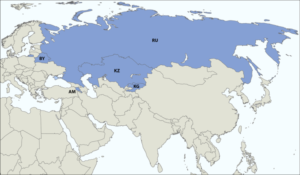After Russia’s unprovoked invasion of Ukraine, a “Defense Contact Group” was created, consisting of more than 45 countries, led by the United States, which is heavily involved in the defense of Ukraine by sending military weapons.
Thanks to the coordination that this group provides, the US, Germany and the UK have already guaranteed the deployment of Multiple Launch Rocket Systems (MLRS) at the request of Ukraine, and the other countries participating in the group have committed to providing everything that the country needs to defend itself.

What is the US-led Ukraine Defense Contact Group and how does it work?
The Ukraine Defense Contact Group consists of a group of countries willing to collaborate to provide weapons and resources to Ukraine that has been suffering a large-scale Russian invasion since February 2022.
According to current United States Secretary of Defense Lloyd Austin, the alliance’s objective is to meet all urgent military needs in Ukraine and its meetings are held at the North Atlantic Treaty Organization (NATO) headquarters in Brussels, Belgium.
Member countries seek to help Ukraine defend itself from Russian attacks and strengthen its long-term defense, and Ukraine’s Deputy Defense Minister Ganna Malyar told local media that “the West must understand that its help cannot be a unique thing, but something that continues until our victory”.
In a room located in the basement of an American military base, in the German city of Stuttgart, the brain of the organization works. In this space, there are soldiers from dozens of countries and a small team from Ukraine led by a three-star General who, at the beginning of each day, determines what his country’s priority demands are.
Almost everything that happens at the military base is extremely confidential and the Ukrainians who are members of the International Donor Coordination Cell (IDCC) cannot share anything and the local routine demands a heightened sense of urgency, according to BBC.
The group’s objective is to locate nations willing to offer weapons, ammunition and military equipment in general. However, it is up to the team to manage the logistics as well as the ammunition compatible with their respective weapons available.
Delivery of supplies is taking place via road, rail, sea and air. According to British Brigadier and Senior Officer Chris King, Russia has tried to reinforce its attacks on supply lines, but there has been no significant damage as of the publication of this article.
Some of the armaments provided by the United States and the Ukraine Defense Group
Ukraine recently announced that the flow of arms is small and slow compared to the Russian offensive, and its cries for help sound more alarming and desperate each day. German Rear Admiral Heinz says Ukraine will not be without weapons.
In the first 4 months of the conflict, Western Allies have already helped deliver nearly $8 billion worth of weapons and ammunition to Ukraine’s armed forces, however, the country’s demand has changed significantly. Initially, the requests were for small arms and caliber, but, nowadays, the demand has changed to heavier weapons.
It is observed that the initial requests for anti-tank and anti-aircraft missiles most used for defense, became distress calls for more offensive weaponry such as heavy artillery, multiple rocket launchers and air defense systems.
In response to requests for heavy weapons from Ukrainians, here are some examples of equipment shipped by the end of June 2022:
- The Czech Republic, Poland, Bulgaria and England sent over 300 Tanks;
- The Czech Republic, Poland and Slovenia sent approximately 136 Infantry Combat Vehicles (AFVs);
- The UK sent approximately 40 Armored Fighting Vehicles (AFVs);
- The United States, United Kingdom, Portugal, Canada, Poland and Italy sent hundreds of Infantry Mobility Vehicles (IMVs);
- The United Kingdom, Estonia, Italy, Portugal, the United States, Australia, Canada, Bulgaria and the Czech Republic sent hundreds of Towed Artillery;
- The Czech Republic, Poland, France, Norway, the Netherlands, Germany, Poland, Italy, Slovakia and the United Kingdom sent approximately 200 items of Self-Propelled Artillery;
- The Czech Republic, Poland, Bulgaria, Germany, the United Kingdom and the United States sent approximately 100 Multiple Rocket Launchers (MRLs);
- Germany sent 15 Self-Propelled Anti-Aircraft Guns (SPAAGs);
- Slovakia, the Czech Republic, the United Kingdom and Germany have deployed approximately 10 Surface-to-Air Missile Systems (SAM);
- Denmark, United Kingdom, Netherlands, United States and Sweden sent several Anti-Ship Missiles (AShMs);
- The United States, Slovakia and the Czech Republic sent several Attack Helicopters;
- Turkey and Lithuania sent several Unmanned Combat Aerial Vehicles (UCAVs) “Drones”.
Among several other equipment and ammunition to be sent so that Ukraine can defend its national territory.
Future trends in the supply of weapons to Ukraine to defend itself against Russian invasion
Brigadier Chris King and Rear Admiral Heinz say they are organizing to continue the activities for the long term as they do not believe this war will end in a few months, but it may go on for years.
Despite this prediction, there is a certain skepticism among some NATO members, as there are doubts about the ability to sustain a longer war, due to their limited stock of weapons and ammunition.
The biggest trend at the moment is the transition from old Ukrainian weapons and ammunition, standard from former Soviet Bloc countries, to current NATO standard equipment. At the beginning of the war, the IDCC tried to obtain Soviet-standard stockpiles, but King claims that these munitions are slowly running out, with only one factory in Europe producing 152 mm artillery compatible with the Soviet Union model.
The transition has already begun slowly, and in recent weeks Ukraine has received more than 100 US M777 howitzers and 300,000 155mm rounds. The additional obstacle is the lack of training by the Ukrainian military to use the new weapons and ammunition. So the IDCC is establishing this capability in the UK with new artillery and rocket launchers offered by the British.
Less complex training can be offered virtually through videos and training manuals. The President’s Chief of Staff Andriy Yermak added that a new comprehensive package of military assistance to Ukraine is scheduled to be discussed at the Alliance summit in Madrid this week.
However, in general, even with the obstacles of supplying and training standard NATO weapons to Ukraine, the tendency is that the “Defense Contact Group” will continue to supply weapons to Ukraine as long as the conflict lasts, even if partner countries have to increase the production and procurement of new military equipment to replace what was donated.
As for Ukraine, the irony is that because of the Russian invasion, even not becoming a NATO member, Ukraine will eventually switch from Soviet-standard to NATO-standard equipment of its armed forces, becoming even closer to the alliance. defense and going in the exact opposite direction that President Putin would like. Yet another example of the total strategic failure of Putin’s military adventure in Ukraine.












Itís hard to find knowledgeable people for this topic, but you seem like you know what youíre talking about! Thanks
Thank you for your support! Let us know if you have any questions!
[…] the impact of the foreign policy of the administration of President Donald Trump, tensions between Russia and the West, the crisis in Syria, the threat of terrorism, cyber security and nuclear weapons […]